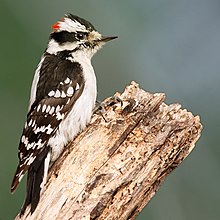Downy Woodpecker
| Downy woodpecker | |
|---|---|
 |
|
| Male | |
 |
|
| Female, Cap Tourmente National Wildlife Area, Quebec, Canada | |
| Scientific classification | |
| Kingdom: | Animalia |
| Phylum: | Chordata |
| Class: | Aves |
| Order: | Piciformes |
| Family: | Picidae |
| Genus: | Dryobates |
| Species: | D. pubescens |
| Binomial name | |
|
Dryobates pubescens (Linnaeus, 1766) |
|
 |
|
| Range of the downy woodpecker | |
| Synonyms | |
|
Picoides pubescens |
|
Picoides pubescens
The downy woodpecker (Dryobates pubescens) is a species of woodpecker, the smallest in North America.
Adult downy woodpeckers are the smallest of North America's woodpeckers but there are many smaller species elsewhere, especially the piculets. The total length of the species ranges from 14 to 18 cm (5.5 to 7.1 in) and the wingspan from 25 to 31 cm (9.8 to 12.2 in). Body mass ranges from 20 to 33 g (0.71 to 1.16 oz). Standard measurements are as follows: the wing chord is 8.5–10 cm (3.3–3.9 in), the tail is 4–6 cm (1.6–2.4 in), the bill is 1–1.8 cm (0.39–0.71 in) and the tarsus is 1.1–1.7 cm (0.43–0.67 in). The downy woodpecker is mainly black on the upperparts and wings, with a white back, throat and belly and white spotting on the wings. There is a white bar above the eye and one below. They have a black tail with white outer feathers barred with black. Adult males have a red patch on the back of the head whereas juvenile birds display a red cap.
The downy woodpecker is virtually identical in plumage pattern to the larger hairy woodpecker, but it can be distinguished from the hairy by the presence of black spots on its white tail feathers and the length of its bill. The downy woodpecker's bill is shorter than its head, whereas the hairy woodpecker's bill is approximately equal to head length.
The downy woodpecker gives a number of vocalizations, including a short pik call. One may identify the woodpecker by pik-call, counting half a second between piks(a total of four must be heard). The rattle-call is short burst that sounds similar to a bouncing ball, while HAWO is a shorter burst of the same amplitude. Like other woodpeckers, it also produces a drumming sound(sounds like four taps Like other woodpeckers, it also produces a drumming sound with its beak as it pecks into trees. Compared to other North American species its drums are slow.
Despite their close resemblance, downy and hairy woodpeckers are not very closely related, and they are likely to be separated in different genera; the outward similarity is a spectacular example of convergent evolution. Why they evolved this way cannot be explained with confidence; it may be relevant that the species exploit rather different-sized foodstuffs and do not compete very much ecologically.
...
Wikipedia

